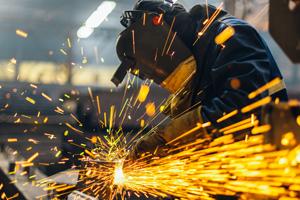Media safes and vaults
Protecting your clients’ documents may require storage in a media safe or vault. There are guidelines that apply to these types of storage enclosures. You should understand the differences between a media vault and a media safe. You can then select the option that best suits your operations and customer needs.
Media vault
NFPA 232, Standard for the Protection of Records, describes a media vault as an enclosure that is equipped, maintained and supervised to minimize the possibility of a fire starting in the vault and the enclosure has a fire resistance rating of four to six hours for fires that would expose the vault. A media vault is specifically designed and has walls, floors and ceiling of fire resistant construction. The minimum fire resistance rating is four hours. The enclosure will be properly sealed and all penetrations closed in a fashion to maintain the fire resistance rating. Entry doors will have a fire resistance rating that matches the rating of the enclosure. Heating systems, electrical system and other utilities are designed to limit ignition sources and loss potential. The vault will be provided with fire suppression systems and fire detection systems.
Media safe
Underwriters Laboratories Inc. (UL) standardized the testing procedure for record protection equipment and has established a labeling service that identifies the degree of protection a device affords. UL 72, Standard for Tests for the Fire Resistance of Record Protection Equipment, provides the UL testing and listing requirements for record protection equipment. You should verify that the media safe you are using meets the appropriate UL listing by examining the UL label that is attached to the door of the safe. You can also research a given product on UL’s online certification website, UL Online Certifications Directory.
A media safe is a UL-listed enclosure that is designed to prevent damage to paper records or electronic media from fire. These cabinets or safes are listed based on the maximum temperature rise that can occur inside the enclosure. The testing process follows a specific time temperature curve. There are three different classes of record protection safes. Record protection equipment is intended to provide protection to one or more types of records, according to an assigned Class rating:
- Class 350 for paper
- Class 150 for magnetic computer tapes and photographic film
- Class 125 for flexible disks.
You must match the class of the media safe to the intended materials to be protected. A Class 350 safe would not protect electronic media, as the allowed temperature rise is too great.
Although the term “safe” is commonly used for these enclosures and they often have combination locks, the standard for media safes does not include testing for burglary resistance. There are tests for impact and drop testing, but this is not the same process used for burglary resistant safes.
Understanding the requirements for vaults and safes as they relate to document storage is a key to your providing the appropriate environment for protection of vital records.
This material is provided for informational purposes only and does not provide any coverage or guarantee loss prevention. The examples in this material are provided as hypothetical and for illustration purposes only. The Hanover Insurance Company and its affiliates and subsidiaries (“The Hanover”) specifically disclaim any warranty or representation that acceptance of any recommendations contained herein will make any premises, or operation safe or in compliance with any law or regulation. By providing this information to you. The Hanover does not assume (and specifically disclaims) any duty, undertaking or responsibility to you. The decision to accept or implement any recommendation(s) or advice contained in this material must be made by you.
JAN 2019 12-61
171-0977 (01/14)
Related resources
Media safes and vaults
Protecting your clients’ documents may require storage in a media safe or vault. There are guidelines that apply to these types of storage enclosures. You should understand the differences between a media vault and a media safe. You can then select the option that best suits your operations and customer needs.
Media vault
NFPA 232, Standard for the Protection of Records, describes a media vault as an enclosure that is equipped, maintained and supervised to minimize the possibility of a fire starting in the vault and the enclosure has a fire resistance rating of four to six hours for fires that would expose the vault. A media vault is specifically designed and has walls, floors and ceiling of fire resistant construction. The minimum fire resistance rating is four hours. The enclosure will be properly sealed and all penetrations closed in a fashion to maintain the fire resistance rating. Entry doors will have a fire resistance rating that matches the rating of the enclosure. Heating systems, electrical system and other utilities are designed to limit ignition sources and loss potential. The vault will be provided with fire suppression systems and fire detection systems.
Media safe
Underwriters Laboratories Inc. (UL) standardized the testing procedure for record protection equipment and has established a labeling service that identifies the degree of protection a device affords. UL 72, Standard for Tests for the Fire Resistance of Record Protection Equipment, provides the UL testing and listing requirements for record protection equipment. You should verify that the media safe you are using meets the appropriate UL listing by examining the UL label that is attached to the door of the safe. You can also research a given product on UL’s online certification website, UL Online Certifications Directory.
A media safe is a UL-listed enclosure that is designed to prevent damage to paper records or electronic media from fire. These cabinets or safes are listed based on the maximum temperature rise that can occur inside the enclosure. The testing process follows a specific time temperature curve. There are three different classes of record protection safes. Record protection equipment is intended to provide protection to one or more types of records, according to an assigned Class rating:
- Class 350 for paper
- Class 150 for magnetic computer tapes and photographic film
- Class 125 for flexible disks.
You must match the class of the media safe to the intended materials to be protected. A Class 350 safe would not protect electronic media, as the allowed temperature rise is too great.
Although the term “safe” is commonly used for these enclosures and they often have combination locks, the standard for media safes does not include testing for burglary resistance. There are tests for impact and drop testing, but this is not the same process used for burglary resistant safes.
Understanding the requirements for vaults and safes as they relate to document storage is a key to your providing the appropriate environment for protection of vital records.
This material is provided for informational purposes only and does not provide any coverage or guarantee loss prevention. The examples in this material are provided as hypothetical and for illustration purposes only. The Hanover Insurance Company and its affiliates and subsidiaries (“The Hanover”) specifically disclaim any warranty or representation that acceptance of any recommendations contained herein will make any premises, or operation safe or in compliance with any law or regulation. By providing this information to you. The Hanover does not assume (and specifically disclaims) any duty, undertaking or responsibility to you. The decision to accept or implement any recommendation(s) or advice contained in this material must be made by you.
JAN 2019 12-61
171-0977 (01/14)
Related resources
Media safes and vaults
Protecting your clients’ documents may require storage in a media safe or vault. There are guidelines that apply to these types of storage enclosures. You should understand the differences between a media vault and a media safe. You can then select the option that best suits your operations and customer needs.
Media vault
NFPA 232, Standard for the Protection of Records, describes a media vault as an enclosure that is equipped, maintained and supervised to minimize the possibility of a fire starting in the vault and the enclosure has a fire resistance rating of four to six hours for fires that would expose the vault. A media vault is specifically designed and has walls, floors and ceiling of fire resistant construction. The minimum fire resistance rating is four hours. The enclosure will be properly sealed and all penetrations closed in a fashion to maintain the fire resistance rating. Entry doors will have a fire resistance rating that matches the rating of the enclosure. Heating systems, electrical system and other utilities are designed to limit ignition sources and loss potential. The vault will be provided with fire suppression systems and fire detection systems.
Media safe
Underwriters Laboratories Inc. (UL) standardized the testing procedure for record protection equipment and has established a labeling service that identifies the degree of protection a device affords. UL 72, Standard for Tests for the Fire Resistance of Record Protection Equipment, provides the UL testing and listing requirements for record protection equipment. You should verify that the media safe you are using meets the appropriate UL listing by examining the UL label that is attached to the door of the safe. You can also research a given product on UL’s online certification website, UL Online Certifications Directory.
A media safe is a UL-listed enclosure that is designed to prevent damage to paper records or electronic media from fire. These cabinets or safes are listed based on the maximum temperature rise that can occur inside the enclosure. The testing process follows a specific time temperature curve. There are three different classes of record protection safes. Record protection equipment is intended to provide protection to one or more types of records, according to an assigned Class rating:
- Class 350 for paper
- Class 150 for magnetic computer tapes and photographic film
- Class 125 for flexible disks.
You must match the class of the media safe to the intended materials to be protected. A Class 350 safe would not protect electronic media, as the allowed temperature rise is too great.
Although the term “safe” is commonly used for these enclosures and they often have combination locks, the standard for media safes does not include testing for burglary resistance. There are tests for impact and drop testing, but this is not the same process used for burglary resistant safes.
Understanding the requirements for vaults and safes as they relate to document storage is a key to your providing the appropriate environment for protection of vital records.
This material is provided for informational purposes only and does not provide any coverage or guarantee loss prevention. The examples in this material are provided as hypothetical and for illustration purposes only. The Hanover Insurance Company and its affiliates and subsidiaries (“The Hanover”) specifically disclaim any warranty or representation that acceptance of any recommendations contained herein will make any premises, or operation safe or in compliance with any law or regulation. By providing this information to you. The Hanover does not assume (and specifically disclaims) any duty, undertaking or responsibility to you. The decision to accept or implement any recommendation(s) or advice contained in this material must be made by you.
JAN 2019 12-61
171-0977 (01/14)
Related resources
Media safes and vaults
Protecting your clients’ documents may require storage in a media safe or vault. There are guidelines that apply to these types of storage enclosures. You should understand the differences between a media vault and a media safe. You can then select the option that best suits your operations and customer needs.
Media vault
NFPA 232, Standard for the Protection of Records, describes a media vault as an enclosure that is equipped, maintained and supervised to minimize the possibility of a fire starting in the vault and the enclosure has a fire resistance rating of four to six hours for fires that would expose the vault. A media vault is specifically designed and has walls, floors and ceiling of fire resistant construction. The minimum fire resistance rating is four hours. The enclosure will be properly sealed and all penetrations closed in a fashion to maintain the fire resistance rating. Entry doors will have a fire resistance rating that matches the rating of the enclosure. Heating systems, electrical system and other utilities are designed to limit ignition sources and loss potential. The vault will be provided with fire suppression systems and fire detection systems.
Media safe
Underwriters Laboratories Inc. (UL) standardized the testing procedure for record protection equipment and has established a labeling service that identifies the degree of protection a device affords. UL 72, Standard for Tests for the Fire Resistance of Record Protection Equipment, provides the UL testing and listing requirements for record protection equipment. You should verify that the media safe you are using meets the appropriate UL listing by examining the UL label that is attached to the door of the safe. You can also research a given product on UL’s online certification website, UL Online Certifications Directory.
A media safe is a UL-listed enclosure that is designed to prevent damage to paper records or electronic media from fire. These cabinets or safes are listed based on the maximum temperature rise that can occur inside the enclosure. The testing process follows a specific time temperature curve. There are three different classes of record protection safes. Record protection equipment is intended to provide protection to one or more types of records, according to an assigned Class rating:
- Class 350 for paper
- Class 150 for magnetic computer tapes and photographic film
- Class 125 for flexible disks.
You must match the class of the media safe to the intended materials to be protected. A Class 350 safe would not protect electronic media, as the allowed temperature rise is too great.
Although the term “safe” is commonly used for these enclosures and they often have combination locks, the standard for media safes does not include testing for burglary resistance. There are tests for impact and drop testing, but this is not the same process used for burglary resistant safes.
Understanding the requirements for vaults and safes as they relate to document storage is a key to your providing the appropriate environment for protection of vital records.
This material is provided for informational purposes only and does not provide any coverage or guarantee loss prevention. The examples in this material are provided as hypothetical and for illustration purposes only. The Hanover Insurance Company and its affiliates and subsidiaries (“The Hanover”) specifically disclaim any warranty or representation that acceptance of any recommendations contained herein will make any premises, or operation safe or in compliance with any law or regulation. By providing this information to you. The Hanover does not assume (and specifically disclaims) any duty, undertaking or responsibility to you. The decision to accept or implement any recommendation(s) or advice contained in this material must be made by you.
JAN 2019 12-61
171-0977 (01/14)





